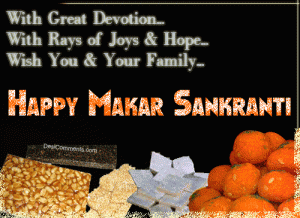Happy Makara Sankraanti!!
Sankraanti means to go from one place to another place (to change direction). It also means one meets another. The time when the sun changes direction from one constellation (of the zodiac) to another is known as Sankraanti. Transition of the Sun from Sagittarius to Capricorn during the winter solstice in the northern hemisphere (Uttaraayana) is known as Makara Sankraanti.
Almost all Hindu festivals are dependent on the position of the moon; however, Makara Sankrāntī is based on the position of the sun. The sun enters the zodiac sign of Makara (Capricorn) on the day of Makara Sankraanti. All the tithi-s (dates) of Hindu festivals vary every year; however, Makara Sankraanti falls mostly on 14 January (occasionally on 13th or 15th January). Every eighty years, the difference created due to the revolution of the earth around the sun is made up by pushing ahead Makara Sankraanti by a day.
Since time immemorial, demons have been troubling humans as well as Deities. When such situations arise, God incarnates and slays the demons. It is said that Sankraanti, a Deity, slayed a demon, Sankraasur, on this day.
All religious festivals are intended to be celebrated in a spiritually correct way so as to derive spiritual benefits from them. However, over a period of time, the local customs influence the celebrations. According to the rule that ‘customs have more impact on people than the Scriptures;’ humans emulate others blindly and celebrate festivals in their own way. Thus Makara Sankraanti is celebrated differently in different parts of India.
We need to understand the spiritual science underlying the celebration of Makara Sankraanti, which will motivate and inspire us to celebrate it in the spiritually correct way.
Importance of Makara Sankraanti:
1) Worldly importance
In India, Makara Sankraanti is celebrated to let go of our differences with each other and increase love (premabhaava) in us. One way people come close together on this day, is by distributing sweets to each other. These sweets are typically made of sesame seeds and jaggery.
2) Spiritual importance
On Makara Sankraanti from sunrise to sunset, the environment is charged with subtle cosmic energy and heightened state of awareness. Thus, a seeker doing saadhanaa (spiritual practice) can derive the maximum benefit from this subtle energy and the heightened state of awareness conducive for saadhanaa. Due to this charged environment, tejtattva (Absolute Fire Principle) also increases in seekers. Therefore the day of Makara Sankraanti is very conducive for saadhanaa.
Spiritual significance of sweets made out of sesame seeds:
a) Before distributing sweets made out of sesame seeds and jaggery, they should be kept in front of an idol or a picture of a Deity on one’s altar. This helps retain the Shakti (Divine energy) and Chaitanya (Divine Consciousness) in the sweets.
b) When distributing sweets made of sesame seeds and jaggery, bhaava (spiritual sentiment) and Chaitanya is awakened in us.
c) All the members of the house derive the benefit of the increased subtle energy and the heightened state of awareness in the environment.
d) The premabhaava (love) in people increases and they are able to overcome negative thinking and replace it with positive thinking.
e) According to Ayurveda, eating sesame seeds in winter is beneficial for our health. Spiritually, sesame seeds and sesame oil have the ability to absorb and emit high amounts of saattvik frequencies more than any other oil. Hence, during Makara Sankraanti, sesame seeds are favorable for good saadhanaa (spiritual practice) to happen.
f) By consuming sesame seed sweets, inner purification happens which helps improve one’s saadhanaa. By distributing these sweets to each other, there is an exchange of saattviktaa, which helps increase everyone’s saattviktaa.
Hindu festivals are great opportunities to imbibe the increased amount of positive energy and the heightened state of awareness in the environment. However this is possible only if one celebrates the festivals as per the guidance of Sanatana Dharma. By adhering to Dharma we can derive the maximum benefit of each festival thereby purifying ourselves as well as the environment.
How is Makar Sankranti celebrated?
Different regions in India celebrate Makara Sankraanti in different ways. The following are some examples of the various rituals that are performed on this day.
1) The period from sunrise to sunset is meritorious. A Holy bath at any Holy place on the banks of the rivers Ganga, Yamuna, Krishna, Godavari, etc., on this day, yields great merits.
2) The period from Makara Sankraanti (14th January in 2025) to Rathsaptami ( 4th February in 2025) is called a Transition period (Parvakaala or Sandhikaala). Any offerings / donations (daana) and meritorious acts done during this period definitely yield fruit.
3) White sesame seeds (til) are used extensively while celebrating Makara Sankraanti. People prepare sweets made of sesame seeds and distribute them to others. Sesame seeds have the ability to absorb and emit high amounts of saattvik frequencies which in turn facilitate spiritual practice.
4) Women celebrate this day with an event known as ‘Haldi-Kumkum’ or ‘Haldi-Kunku’. They apply turmeric and kumkum (vermilion) on the forehead of other women at the site of the aajnyaa-chakra, apply perfume (attar) on hands-forearms-feet, offer 13 types of saattvik gifts (vaan), sprinkle rose water on them, offer sweets made of sesame seeds and jaggery and do the ritual of offering a sārī and / or a piece of cloth to a female Deity or to a married woman (Oti).


Chintu
The significance of Makar Sankranti is shown in detail, very useful for clear understanding.